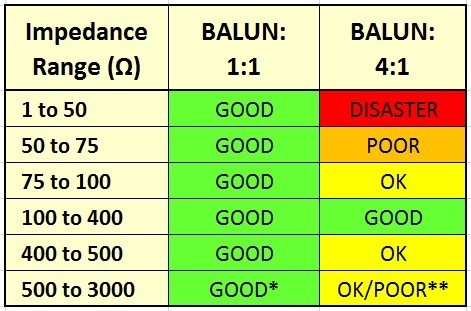BALUN TRUTH TABLE
( for tuner baluns )
The TRUTH TABLE pictured below should be viewed as a guide for making balun choices.
There will always be exceptions to any rule of thumb.
BUT . . .
- * ONLY “GOOD” if the matchbox itself is capable of matching this range efficiently, AND of course if you are using a good quality CURRENT balun capable of coping with the voltage and current requirements for the task.
- ** Whether it is OK or POOR will depend on how much Common Mode Current (CMC) problems the antenna and its installation produce. This can be very different from one QTH to the next, even though the antenna is the same. If the antenna does not have much problem with CMC, then it can even be GOOD; if there is only small CMC trouble, then it is OK, but if there is larger CMC trouble, the 4:1 is very poor at impeding CMC. Regardless of CMC, it still transforms the impedance.
If you have a matchbox which cannot match up to 3000 Ohms and you expect CMC trouble, then you must use a Hybrid Balun. This is a combination of two baluns. The first one (connected to the antenna) will be a 4:1 balun, then connected directly below that is a 1:1 balun.
In general, current baluns are good for impeding CMC, but voltage baluns are useless.
In the case of the hybrid balun, the 1:1 is for impeding CMC, the 4:1 is for matching, and it does not matter much whether the 4:1 is a current or voltage balun.
In Practice:
- If you have a long antenna, like an 80m dipole fed with Openwire, then its impedance is going to be high in Ohms (except on 80) and also EXCEPT WITH CERTAIN LENGTHS OF FEEDLINES. In general we
can assume it is high on most bands..
- If we don’t have bad CMC problems, then in general the 4:1 balun will perform OK, but it MUST be a current balun.
- However, if we run into problems with CMC, then a 1:1 balun is better, but keep in mind that by very high impedances, a hybrid balun may be necessary. This will depend on the matchbox’s matching ability.
- If you have a short antenna, the story changes completely. Example: 40m dipole, fed with openwire, but used on all bands.
- The impedance is high on 20m and above, but the impedance is low on 40 and very low on 80m.
- Although a 4:1 balun is OK to use on the high bands, it can cause problems on 40 and BIG TROUBLE on 80m.
- MUCH BETTER is to use a 1:1 current balun.
- POWER:
- With QRP, in general anything will work without getting problems with CMC. In fact even a voltage balun will work. It doesn’t matter which one you choose unless the 4:1 ratio transfers the impedance below the matching range of the matchbox.
- With 100w, the situation is often the same as with QRP, except in cases where you have heavy CMC problems. Then you should follow the general guide lines of the Truth Table and stick with 1:1 current baluns to tame the CMC. However with 100w, it is better to always use current baluns. If you have a voltage balun, rewind them or throw them out!
- Up to 750w, the situation can get critical, especially with very high or very low impedances. Here the 1:1 current balun is generally going to be a much better choice.
- 1.5 kW, the situation is very critical. Here you must avoid the 4:1 balun. A 1:1 current balun is best. I recommend following the advice of GM3SEK or K9YC on the construction of the baun/choke for high power. See The Balun Experts for links to these two resources.
As you see, which balun to use depends on the antenna, and to some extent the matchbox (i.e. in cases where its matching range might impose restrictions).


























